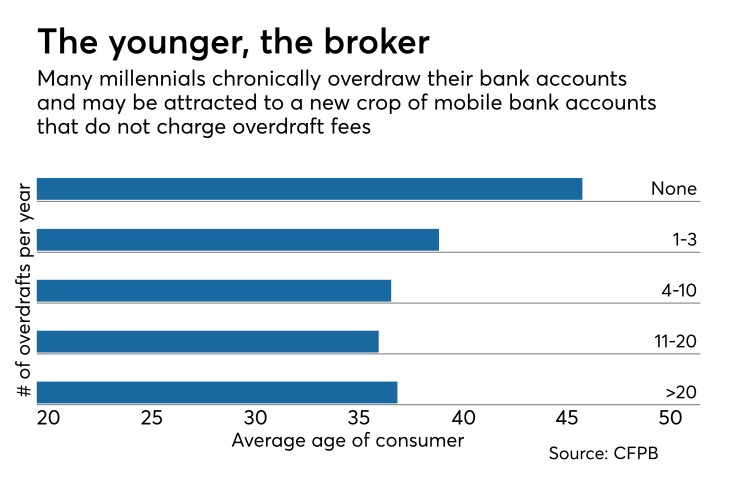If you’re wondering whether startups are starting to shake up the consumer deposit business, look no further than Wells Fargo’s Greenhouse and JPMorgan Chase’s Finn.
The two banking giants are taking a page from Silicon Valley by offering mobile accounts that do not charge overdraft fees. That marks a significant shift inside an industry that rakes in roughly $15 billion in annual charges from customers who spend funds that they do not have.
Chase and Wells, like the rest of the banking industry, are wrestling with the question of how to appeal to young adults who are establishing lasting financial relationships. But they also have reason to worry that as-yet-unprofitable startups are resetting customer expectations about fees.
Over the last several years, numerous venture-capital-backed firms have begun offering transaction accounts aimed at millennials who live on their smartphones, see little value in branches and generally have less money than their parents, which makes them more susceptible to $35 overdraft charges.
These accounts typically do not allow overdrafts; when customers without sufficient funds swipe their debit cards, the transactions are denied.

Varo Money, which was founded in 2015, is one of these new entrants. The San Francisco company does not charge a monthly service fee, and it has no minimum balance requirement.
CEO Colin Walsh said in a recent interview that the average age of Varo Money’s customers is 30, and some 85% of those account holders are between 22 and 36 years old.
Walsh, whose long career in finance has included stints at Wells Fargo and American Express, said that banks have no choice but to experiment with the kinds of products being offered by startups.
“They have to do it,” Walsh said. “Their customer base is aging out.”
This problem is actually less severe for big banks, which have invested large sums of money in developing a compelling experience for their mobile banking users, than it is for smaller institutions. But even the megabanks are facing competitive pressure from mobile-only accounts.
Wells Fargo is planning a multistate launch for Greenhouse later this year. The app features money management tools that are designed to help customers ensure that they only spend funds that are available to them.
“The Greenhouse experience is being built to meet specific needs of those new to banking, like students, as well as specific customer segments — like gig economy workers and freelancers,” Ed Kadletz, head of the bank’s deposit products group, said in an email.
“Our goal for Greenhouse customers is to never authorize a purchase or payment if the account doesn’t have enough funds,” he added.
Finn by Chase, which was launched last fall, has a similar structure.
The mobile bank account does not include a monthly service fee or overdraft fees. Customers cannot get help with their Finn accounts at Chase branches, but they do get free access to more than 29,000 ATMs. Chase did not make an executive available for an interview about the product.
It is notable that Wells Fargo and Chase both launched their mobile bank accounts under new brand names. That decision may yield a couple of advantages.
For one, existing bank customers who are frustrated with overdraft fees may be less likely to demand a no-fee account if it is operating under a different brand name.
In addition, there may be an opportunity to develop new brands that are untainted by consumers’ negative perceptions of big banks.
Fintech brands that offer simple products are resonating with millennials, said Rob Berini, a managing director at Deloitte. “It’s certainly true that there’s an opportunity to connect with the millennial segment around brand in a way that creates emotional resonance,” he said.
Peter Wannemacher, an analyst at Forrester Research, said that Greenhouse and Finn both represent experiments in how to connect with a segment of customers who want mobile-only banking. He complimented Wells Fargo and Chase for taking chances, but he also warned that they may be conditioning some customers to expect fee-free accounts.
Both Wells and Chase have collected more than $1.5 billion in annual revenue from consumer overdraft charges in recent years, according to data from the Federal Deposit Insurance Corp.
“I think there’s a major risk in the setting of expectations,” Wannemacher said. “It’s not clear what the business model, what the long-term business model, will be.”
But there are also risks to banks that choose not to respond to new competition from startups.
Hank Israel, a director at the bank advisory firm Novantas, said that the rising popularity of payment apps such as PayPal and Venmo has made it harder for consumers to track inflows and outflows from their accounts, which has in turn made it harder for customers with low account balances to avoid overdraft fees.
That trend suggests there may be a growing consumer demand for overdraft-free products.
Israel also noted that while customers used to make decisions about where to open checking accounts based almost entirely on which banks situated branches near their homes, that is far less true in 2018.
Recent research indicates that roughly 40% of decisions about which account to open are based on which product meets customers’ specific needs, Israel said. “And that number really seems to be growing.”





